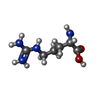Entry Database : PDB / ID : 1ypeTitle Thrombin Inhibitor Complex Hirudin Thrombin heavy chain Thrombin light chain Keywords / / / / / Function / homology Function Domain/homology Component
/ / / / / / / / / / / / / / / / / / / / / / / / / / / / / / / / / / / / / / / / / / / / / / / / / / / / / / / / / / / / / / / / / / / / / / / / / / / / / / / / / / / / / / / / / / / / / / / / / / / / / / / / / / / / / / / / / / / / / / / / Biological species Homo sapiens (human)Hirudo medicinalis (medicinal leech)Method / / Resolution : 1.81 Å Authors Fokkens, J. / Obst-Sander, U. / Heine, A. / Diederich, F. / Klebe, G. Journal : Angew.Chem.Int.Ed.Engl. / Year : 2006Title : A simple protocol to estimate differences in protein binding affinity for enantiomers without prior resolution of racematesAuthors : Fokkens, J. / Klebe, G. History Deposition Jan 31, 2005 Deposition site / Processing site Revision 1.0 Jan 17, 2006 Provider / Type Revision 1.1 Apr 30, 2008 Group Revision 1.2 Jul 13, 2011 Group Atomic model / Database references ... Atomic model / Database references / Derived calculations / Non-polymer description / Structure summary / Version format compliance Revision 1.3 Dec 12, 2012 Group Revision 1.4 Mar 13, 2013 Group Revision 1.5 Nov 6, 2013 Group Revision 1.6 Oct 11, 2017 Group / Category Revision 1.7 Nov 6, 2024 Group Data collection / Database references ... Data collection / Database references / Derived calculations / Structure summary Category chem_comp_atom / chem_comp_bond ... chem_comp_atom / chem_comp_bond / database_2 / pdbx_entry_details / pdbx_modification_feature / pdbx_struct_conn_angle / struct_conn / struct_conn_type / struct_site Item _database_2.pdbx_DOI / _database_2.pdbx_database_accession ... _database_2.pdbx_DOI / _database_2.pdbx_database_accession / _pdbx_struct_conn_angle.ptnr1_PDB_ins_code / _pdbx_struct_conn_angle.ptnr1_auth_comp_id / _pdbx_struct_conn_angle.ptnr1_auth_seq_id / _pdbx_struct_conn_angle.ptnr1_label_asym_id / _pdbx_struct_conn_angle.ptnr1_label_comp_id / _pdbx_struct_conn_angle.ptnr1_label_seq_id / _pdbx_struct_conn_angle.ptnr1_symmetry / _pdbx_struct_conn_angle.ptnr3_PDB_ins_code / _pdbx_struct_conn_angle.ptnr3_auth_comp_id / _pdbx_struct_conn_angle.ptnr3_auth_seq_id / _pdbx_struct_conn_angle.ptnr3_label_asym_id / _pdbx_struct_conn_angle.ptnr3_label_comp_id / _pdbx_struct_conn_angle.ptnr3_label_seq_id / _pdbx_struct_conn_angle.ptnr3_symmetry / _pdbx_struct_conn_angle.value / _struct_conn.conn_type_id / _struct_conn.id / _struct_conn.pdbx_dist_value / _struct_conn.pdbx_leaving_atom_flag / _struct_conn.pdbx_ptnr1_PDB_ins_code / _struct_conn.pdbx_ptnr2_PDB_ins_code / _struct_conn.ptnr1_auth_asym_id / _struct_conn.ptnr1_auth_comp_id / _struct_conn.ptnr1_auth_seq_id / _struct_conn.ptnr1_label_asym_id / _struct_conn.ptnr1_label_atom_id / _struct_conn.ptnr1_label_comp_id / _struct_conn.ptnr1_label_seq_id / _struct_conn.ptnr1_symmetry / _struct_conn.ptnr2_auth_asym_id / _struct_conn.ptnr2_auth_comp_id / _struct_conn.ptnr2_auth_seq_id / _struct_conn.ptnr2_label_asym_id / _struct_conn.ptnr2_label_atom_id / _struct_conn.ptnr2_label_comp_id / _struct_conn.ptnr2_label_seq_id / _struct_conn.ptnr2_symmetry / _struct_conn_type.id / _struct_site.pdbx_auth_asym_id / _struct_site.pdbx_auth_comp_id / _struct_site.pdbx_auth_seq_id
Show all Show less
 Open data
Open data Basic information
Basic information Components
Components Keywords
Keywords Function and homology information
Function and homology information Homo sapiens (human)
Homo sapiens (human) Hirudo medicinalis (medicinal leech)
Hirudo medicinalis (medicinal leech) X-RAY DIFFRACTION /
X-RAY DIFFRACTION /  MOLECULAR REPLACEMENT / Resolution: 1.81 Å
MOLECULAR REPLACEMENT / Resolution: 1.81 Å  Authors
Authors Citation
Citation Journal: Angew.Chem.Int.Ed.Engl. / Year: 2006
Journal: Angew.Chem.Int.Ed.Engl. / Year: 2006 Structure visualization
Structure visualization Molmil
Molmil Jmol/JSmol
Jmol/JSmol Downloads & links
Downloads & links Download
Download 1ype.cif.gz
1ype.cif.gz PDBx/mmCIF format
PDBx/mmCIF format pdb1ype.ent.gz
pdb1ype.ent.gz PDB format
PDB format 1ype.json.gz
1ype.json.gz PDBx/mmJSON format
PDBx/mmJSON format Other downloads
Other downloads 1ype_validation.pdf.gz
1ype_validation.pdf.gz wwPDB validaton report
wwPDB validaton report 1ype_full_validation.pdf.gz
1ype_full_validation.pdf.gz 1ype_validation.xml.gz
1ype_validation.xml.gz 1ype_validation.cif.gz
1ype_validation.cif.gz https://data.pdbj.org/pub/pdb/validation_reports/yp/1ype
https://data.pdbj.org/pub/pdb/validation_reports/yp/1ype ftp://data.pdbj.org/pub/pdb/validation_reports/yp/1ype
ftp://data.pdbj.org/pub/pdb/validation_reports/yp/1ype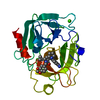
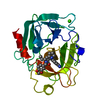
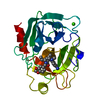
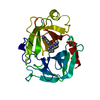
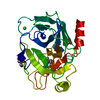
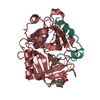
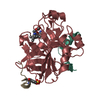
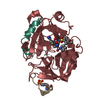
 Links
Links Assembly
Assembly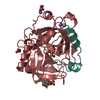
 Components
Components Homo sapiens (human) / Tissue: blood / References: UniProt: P00734, thrombin
Homo sapiens (human) / Tissue: blood / References: UniProt: P00734, thrombin Hirudo medicinalis (medicinal leech) / References: UniProt: P28504, UniProt: P01050*PLUS
Hirudo medicinalis (medicinal leech) / References: UniProt: P28504, UniProt: P01050*PLUS Homo sapiens (human) / Tissue: blood / References: UniProt: P00734, thrombin
Homo sapiens (human) / Tissue: blood / References: UniProt: P00734, thrombin
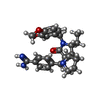





 X-RAY DIFFRACTION / Number of used crystals: 1
X-RAY DIFFRACTION / Number of used crystals: 1  Sample preparation
Sample preparation ROTATING ANODE / Type: RIGAKU RU300 / Wavelength: 1.5418 Å
ROTATING ANODE / Type: RIGAKU RU300 / Wavelength: 1.5418 Å Processing
Processing MOLECULAR REPLACEMENT / Resolution: 1.81→10 Å / Num. parameters: 10349 / Num. restraintsaints: 9755 / Cross valid method: FREE R / σ(F): 0 / σ(I): 0 / Stereochemistry target values: ENGH & HUBER
MOLECULAR REPLACEMENT / Resolution: 1.81→10 Å / Num. parameters: 10349 / Num. restraintsaints: 9755 / Cross valid method: FREE R / σ(F): 0 / σ(I): 0 / Stereochemistry target values: ENGH & HUBER Movie
Movie Controller
Controller



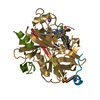


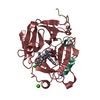
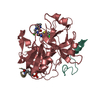
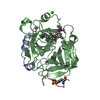
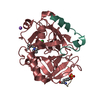
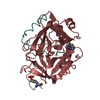
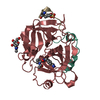

 PDBj
PDBj








